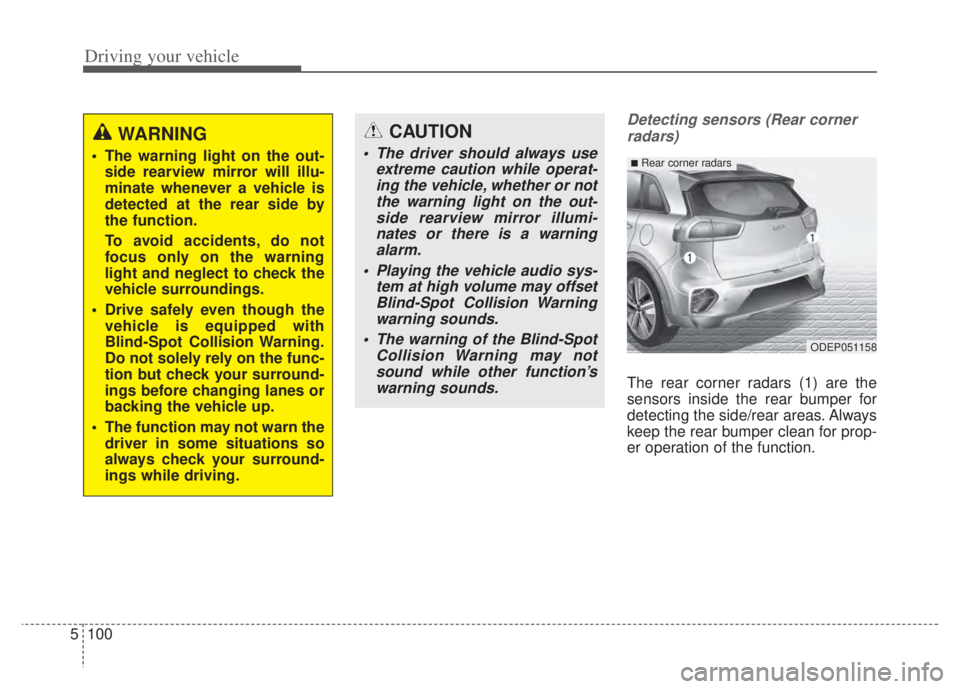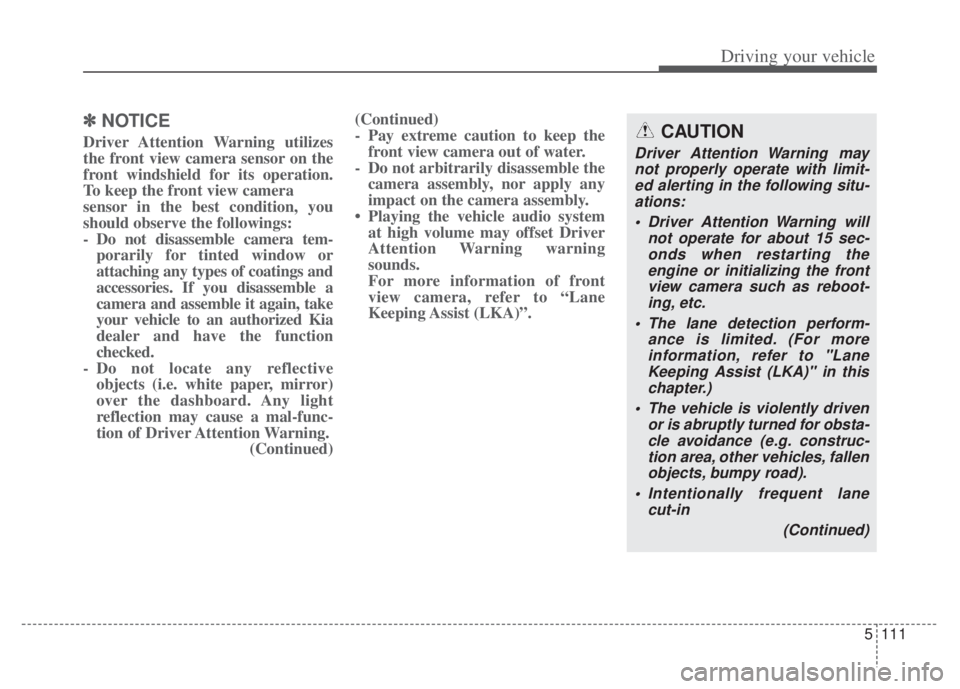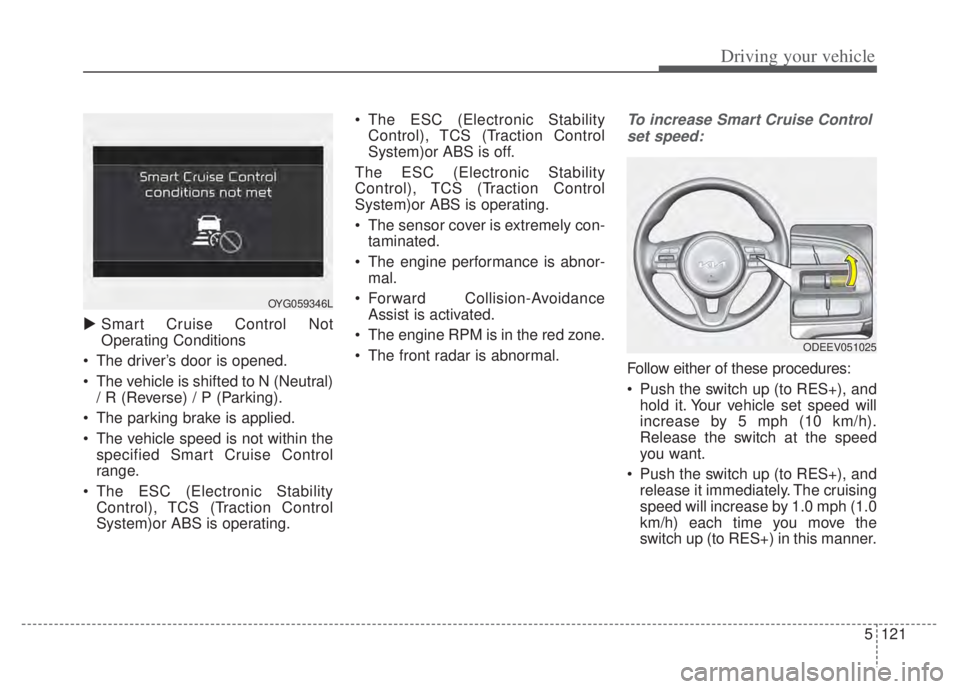sensor KIA NIRO PHEV 2022 Service Manual
[x] Cancel search | Manufacturer: KIA, Model Year: 2022, Model line: NIRO PHEV, Model: KIA NIRO PHEV 2022Pages: 710, PDF Size: 10.35 MB
Page 412 of 710

589
Driving your vehicle
To activate/deactivate Lane Keeping
Assist:
With the ignition switch or ENGINE
START/STOP button in the ON posi-
tion, press and hold the Lane Driving
Assist button ( ) located on the
steering wheel to turn off Lane
Keeping Assist. Press and hold the
button again to turn on the function.
The indicator ( ) in the cluster
display will initially illuminate white. If
you pressing and holding the Lane
Driving Assist button located on the
steering wheel, Lane Keeping Assist
will be turned off and the indicator on
the cluster display will go off.❈
The color of indicator will change
depend on the condition of Lane
Keeping Assist.
- White : Sensor does not detect the lane marker or vehi-
cle speed is less than 40
mph (60 km/h).
- Green : Sensor detects the lane marker and function is
able to control the steer-
ing.
Lane Keeping Assist setting
The driver can change Lane Keeping
Assist to Lane Depar ture Warning or
change the Lane Keeping Assist
mode from the LCD display.
“User Settings Driver Assistance
Lane Safety Lane Keeping
Assist/Lane Departure Warning/Off ”
Lane Keeping Assist
Lane Keeping Assist mode guides
the driver to keep the vehicle within
the lanes. It rarely controls the steer-
ing wheel, when the vehicle drives
well inside the lanes. However, it
starts to control the steering wheel,
when the vehicle is about to deviate
from the lanes.ODEEV051027
Page 418 of 710

595
Driving your vehicle
(Continued)
• There is a boundary structure inthe roadway.
• The light of street, sun, or oncom- ing vehicle reflects from the water
on the road.
• When light shines brightly in the reverse direction you drive.
• Road surface is not even.
• The distance from the vehicle ahead is very short or the vehicle
ahead drives hiding the lane line.
• You drive on a steep grade or a sharp curve.
• The vehicle vibrates heavily.
• The temperature near inside mir- ror is very high due to direct sun
light and etc.
when front visibility is poor
• The lens or windshield is covered by strange materials.
• The sensor cannot detect the lane because of fog, heavy rain or snow.
• The windshield is fogged by humid air in the vehicle.
• Putting something on the crash pad and etc.
WARNING
Lane Keeping Assist is a func-
tion to help prevent the driver
from leaving the lane. However,
the driver should not solely rely
on the function and should
always drive safely and exercise
safe driving practices.
Page 419 of 710

Driving your vehicle
96
5
Blind-Spot Collision Warning uses
radar sensors in the rear bumper to
monitor and warn the driver of an
approaching vehicle in the driver's
blind spot area.
1) Blind-Spot Area
It warns by detecting the vehicles in
the blind spots.
The blind spot detection range varies
relative to vehicle speed.
Note that if your vehicle is traveling
much faster than the vehicles around
you, the warning will not occur. 2) Closing at high speed
Blind-Spot Collision Warning feature
will warn you when a vehicle is
approaching in an adjacent lane at a
high rate of speed. If the driver acti-
vates the turn signal when the func-
tion detects an oncoming vehicle, the
function sounds an audible warning.
BLIND-SPOT COLLISION WARNING (BCW) (IF EQUIPPED)
OSK3058089L
OSK3058090L
WARNING
• Blind-Spot Collision Warning
is a supplemental function to
assist you. Do not entirely rely
on the function.
Always pay attention, while
driving, for your safety.
Always be aware of road con- ditions while driving and be
warn for unexpected situa-
tions even though Blind-Spot
Collision Warning is operat-
ing.
Blind-Spot Collision Warning is not a substitute for proper
and safe driving. Always drive
safely and use caution when
changing lanes or backing up
the vehicle. BCW may not
detect every object alongside
the vehicle.
Page 423 of 710

Driving your vehicle
100
5
CAUTION
The driver should always use
extreme caution while operat-ing the vehicle, whether or notthe warning light on the out-side rearview mirror illumi-nates or there is a warningalarm.
Playing the vehicle audio sys- tem at high volume may offsetBlind-Spot Collision Warningwarning sounds.
The warning of the Blind-Spot Collision Warning may notsound while other function’swarning sounds.
Detecting sensors (Rear corner
radars)
The rear corner radars (1) are the
sensors inside the rear bumper for
detecting the side/rear areas. Always
keep the rear bumper clean for prop-
er operation of the function.
WARNING
The warning light on the out- side rearview mirror will illu-
minate whenever a vehicle is
detected at the rear side by
the function.
To avoid accidents, do not
focus only on the warning
light and neglect to check the
vehicle surroundings.
Drive safely even though the vehicle is equipped with
Blind-Spot Collision Warning.
Do not solely rely on the func-
tion but check your surround-
ings before changing lanes or
backing the vehicle up.
The function may not warn the driver in some situations so
always check your surround-
ings while driving.
ODEP051158
■Rear corner radars
Page 424 of 710

5101
Driving your vehicle
Warning message
Blind-Spot Collision Warning (BCW)
system disabled. Radar blocked
This warning message may appearwhen :
- One or both of the sensors on therear bumper is blocked by dirt or
snow or a foreign object.
- Driving in rural areas where the sensor does not detect another
vehicle for an extended period of
time.
- When there is inclement weather such as heavy snow or rain.
CAUTION
Blind-Spot Collision Warning may not work properly whenthe bumper has been dam-aged, or if the rear bumper hasbeen replaced or repaired.
The sensing range differs some- what according to the width ofthe road. When the road is nar-row, the function may detectother vehicles in the next lane.
The function may turn off due to strong electromagnetic waves.
Always keep the sensor or near the sensor clean.
Never arbitrarily disassemble the sensor component norapply any impact on the sen-sor component.
Be careful not to apply unnec- essary force on the radar sen-sor or sensor cover. If the sen-sor is forcibly moved out ofproper alignment, the functionmay not operate correctly. Inthis case, a warning messagemay not be displayed.
(Continued)
(Continued)Have the vehicle inspected byan authorized Kia dealer.
Do not apply foreign objects such as a bumper sticker or abumper guard near the radarsensor or apply paint to thesensor area. Doing so mayadversely affect the perform-ance of the sensor.
Never install any accessories or stickers on the front wind-shield, nor tint the front wind-shield.
Pay extreme caution to keep the camera sensor out of water.
Never locate any reflective objects (i.e. white paper, mir-ror) over the crash pad. Anylight reflection may cause amalfunction of the function.
OJF058433L
Page 425 of 710

Driving your vehicle
102
5
If any of these conditions occur, the
light on the Blind-Spot Safety button
and the function will turn off automat-
ically.
Turn off Blind-Spot Collision Warning
(if equipped) when a trailer or carrier
is installed.
- Press the Blind-Spot Safety button
(the indicator on the button extin-
guish) or “User Settings Driver
Assistance Blind-Spot Safety
Off ”.
- Deactivate Rear Cross-Traffic Collision Warning by deselecting
“User Settings Driver Assistance
Blind-Spot Safety Rear Cross-
Traffic Safety”.
If you use Blind-Spot Collision
Warning, remove a trailer or carri-
er. When Blind-Spot Collision Warning
canceled warning message is dis-
played in the cluster, check to make
sure that the rear bumper is free from
any dirt or snow in the areas where
the sensor is located. Remove any
dirt, snow, or foreign material that
could interfere with the radar sensors.
After any dirt or debris is removed,
Blind-Spot Collision Warning should
operate normally after about 10 min-
utes of driving the vehicle.
If the function still does not operate
normally, have your vehicle inspect-
ed by an authorized Kia dealer.
Check Blind-Spot Collision Warning
system
If there is a problem with Blind-Spot
Collision Warning, a warning message
will appear and the light on the switch
will turn off. The function will turn off
automatically. We recommend that
you have your vehicle inspected by an
authorized Kia dealer.
OJF058435L
Page 426 of 710

5103
Driving your vehicle
Limitations of Blind-SpotCollision Warning
The driver must be cautious in the
below situations, because the func-
tion may not detect other vehicles or
objects in certain circumstances.
When a trailer or carrier is installed.
The vehicle drives in inclement weather such as heavy rain or
snow.
The sensor is polluted with rain, snow, mud, etc.
The rear bumper where the sensor is located is covered with a foreign
object such as a bumper sticker, a
bumper guard, a bike rack, etc.
The rear bumper is damaged, or the sensor is out of the original
default position.
The vehicle height gets lower or higher due to heavy loading in a
liftgate, abnormal tire pressure,
etc.
When the temperature of the rear bumper is high.
When the sensors are blocked by other vehicles, walls or parking-lot
pillars. The vehicle drives on a curved road.
The vehicle drives through a tollgate.
The road pavement (or the periph-
eral ground) abnormally contains
metallic components (i.e. possibly
due to subway construction).
There is a fixed object near the vehicle, such as a guardrail.
While going down or up a steep road where the height of the lane is
different.
Driving on a narrow road where trees or grass or overgrown.
Driving in rural areas where the sensor does not detect another
vehicle or structure for an extended
period of time.
Driving on a wet road.
Driving on a road where the guardrail or wall is in double structure.
A big vehicle is near such as a bus or truck.
When the other vehicle approach- es very close.
When the other vehicle passes at a very fast speed. While changing lanes.
If the vehicle has started at the
same time as the vehicle next to
you and has accelerated.
When the vehicle in the next lane moves two lanes away from you
OR when the vehicle two lanes
away moves to the next lane from
you.
A motorcycle or bicycle is near.
A flat trailer is near.
If there are small objects in the detecting area such as a shopping
cart or a baby stroller.
If there is a low height vehicle such as a sports car.
The brake pedal is depressed.
ESC (Electronic Stability Control) is activated.
ESC (Electronic Stability Control) malfunctions.
The tire pressure is low or a tire is damaged.
The brake is reworked.
Page 434 of 710

5111
Driving your vehicle
✽ ✽NOTICE
Driver Attention Warning utilizes
the front view camera sensor on the
front windshield for its operation.
To keep the front view camera
sensor in the best condition, you
should observe the followings:
- Do not disassemble camera tem-
porarily for tinted window or
attaching any types of coatings and
accessories. If you disassemble a
camera and assemble it again, take
your vehicle to an authorized Kia
dealer and have the function
checked.
- Do not locate any reflective objects (i.e. white paper, mirror)
over the dashboard. Any light
reflection may cause a mal-func-
tion of Driver Attention Warning. (Continued)(Continued)
- Pay extreme caution to keep the
front view camera out of water.
- Do not arbitrarily disassemble the camera assembly, nor apply any
impact on the camera assembly.
• Playing the vehicle audio system at high volume may offset Driver
Attention Warning warning
sounds.
For more information of front
view camera, refer to “Lane
Keeping Assist (LKA)”.CAUTION
Driver Attention Warning may
not properly operate with limit-ed alerting in the following situ-ations:
Driver Attention Warning will not operate for about 15 sec-onds when restarting theengine or initializing the frontview camera such as reboot-ing, etc.
The lane detection perform- ance is limited. (For moreinformation, refer to "LaneKeeping Assist (LKA)" in thischapter.)
The vehicle is violently driven or is abruptly turned for obsta-cle avoidance (e.g. construc-tion area, other vehicles, fallenobjects, bumpy road).
Intentionally frequent lane cut-in
(Continued)
Page 444 of 710

5121
Driving your vehicle
Smart Cruise Control Not
Operating Conditions
The driver’s door is opened.
The vehicle is shifted to N (Neutral) / R (Reverse) / P (Parking).
The parking brake is applied.
The vehicle speed is not within the specified Smart Cruise Control
range.
The ESC (Electronic Stability Control), TCS (Traction Control
System)or ABS is operating. The ESC (Electronic Stability
Control), TCS (Traction Control
System)or ABS is off.
The ESC (Electronic Stability
Control), TCS (Traction Control
System)or ABS is operating.
The sensor cover is extremely con- taminated.
The engine performance is abnor- mal.
Forward Collision-Avoidance Assist is activated.
The engine RPM is in the red zone.
The front radar is abnormal.
To increase Smart Cruise Control set speed:
Follow either of these procedures:
Push the switch up (to RES+), and hold it. Your vehicle set speed will
increase by 5 mph (10 km/h).
Release the switch at the speed
you want.
Push the switch up (to RES+), and release it immediately. The cruising
speed will increase by 1.0 mph (1.0
km/h) each time you move the
switch up (to RES+) in this manner.
OYG059346L
ODEEV051025
Page 446 of 710

5123
Driving your vehicle
Smart Cruise Control will be tem-porarily canceled when:
Canceled manually
Smart Cruise Control is temporarily
canceled when the brake pedal is
depressed or the CANCEL button is
pressed. The speed and vehicle dis-
tance indicator on the cluster is dis-
appeared and the cruise indicator
(CRUISE) is illuminated continuous-
ly. Canceled automatically
Smart Cruise Control will automati-
cally cancel in the following situa-
tions:
The driver's door is opened.
The shift lever is shifted to N
(Neutral), R (Reverse) or P (Paking).
The EPB (Electronic Parking Brake) is applied.
The vehicle speed is over 120 mph (190 km/h)
The ESC, ABS or TCS is operating.
The ESC is turned off.
The sensor or the cover is dirty or blocked with foreign matter.
The accelerator pedal is continu- ously depressed for long time.
The engine speed is in dangerous range.
Smart Cruise Control has malfunc- tioned.
When the braking control is operat- ed for Forward Collision-Avoidance
Assist.
The vehicle stops and goes repeat- edly for a long period of time. When the parking brake is locked
Speed of the vehicle has been
decreased to less than 5 mph (10
km/h)
Engine has some problems
Each of these actions will cancel
Smart Cruise Control operation. (The
set speed of the cluster is displayed in
gray shades and the distance indica-
tor with the vehicle ahead is disap-
peared.)
In a condition Smart Cruise Control
is cancelled automatically, Smart
Cruise Control will not operate even
though the RES+ or SET- switch is
moved.
The EPB (Electronic Parking Brake)
is applied when Smart Cruise
Control auto release condition
occurs while Smart Cruise Control is
in use.
ODEP051026